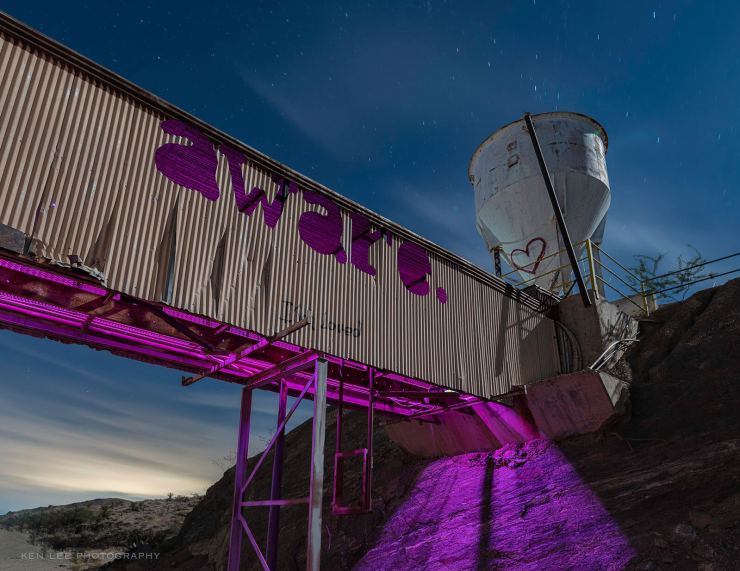One of the best parts of photographing with other night photographers is the camaraderie and collaboration. Sometimes, it’s better to have several people working together while creating an image with light painting.
I’ll describe how we went about illuminating this photo during the long exposure. Collaborative light painting can be a beautiful, powerful method. But first, I’ll discuss the vandalism/art that you see in the photo.

Aware of destruction, aware of art
Aware is a guerrilla vandal/artist that recently passed away. Revered among many graffiti artists, his passing reverberated throughout the community.
Aware was part of a collective of artists and activists known for making political statements. They were known for making statements through art, graffiti, vandalism and more, pointing out corporate greed against Wall Street and protesting police brutality against African Americans. Here at this remote mining complex, this collective created art to protest environmental destruction and the poisoning of our planet.
The art and vandalism creates polarized opinions. Many regard Aware as daring guerrilla artists making important and necessary statements. Others regard them as vandals hellbent on destroying abandoned property. As is so often the case, many view these actions through an either/or “us vs. them” lens. They can be both of these things, and more.
Three steps to photographing the walkway
Several of us night photographers travel together occasionally, taking photos during the full moon. We always have a great time.
1. Illuminating the interior of the walkway
George Loo, who developed the ProtoMachines light painting devices, climbed up the stairs to light the interior of the overhead walkway. He chose a deep purple light. He walked along the entire length of the walkway with his ProtoMachines lit. The purple light creates depth inside and spills out onto the rocky mountain face below. Also notice how George used shallow angles in the interior to bring out details and create depth.
2. Bringing out the details
I loved the way the moon was lighting the corrugated walkway. In fact, that’s largely what inspired me to take the photo. Mimicking the way the moon created shadows, I illuminated it from a similar direction. This created further detail while looking natural.
3. Collaborating
We communicated throughout the shoot. For instance, George would announce that he was about to walk through the overhead walkway. Timothy Little and I would count down a bit, and then trigger the cameras before he began walking through.
George, Timothy, Mike Cooper and I communicate not only when collaborating on an image together, but also to make sure we don’t blast someone with light and interfere with their photo. For longer distances, we use Motorola two-way radios to communicate with each other.
Why don’t I show up in the photo?
When I illuminated the interior, I walked through the frame — twice! Why didn’t I register? It’s because I walked quickly through an exposure that was several minutes long.
Generally, unless you inadvertently flash a light on yourself, you don’t begin to show up in a photo until you have been standing still for approximately 10% of the overall exposure! So yes, you can walk through the scene and not show up. Spooky, huh?
Tell your story with the second annual Visual Storytelling Conference!
Experience four days of interactive, online training sessions featuring a range of educational content with experienced photographers and content creators. This free event kicks off with a series of technical boot camps to build essential skills, followed by live, online sessions on photography, video, business and social media. Join live from March 10-13, 2022!
